Comparative Mitogenomics Reveals Cryptic Species in Sillago ingenuua McKay, 1985 (Perciformes: Sillaginidae)
Abstract
1. Introduction
2. Materials and Methods
2.1. Sample Collection
2.2. Morphological Analysis
2.3. DNA Extraction and PCR Amplification
2.4. Genetic Analysis
3. Results and Discussions
3.1. Taxonomy and Cryptic Diversity
3.2. General Features of the Mitogenomes
3.3. Protein-Coding Genes and Codon Usage
3.4. Transfer and Ribosomal RNA Genes
3.5. Control Region
3.6. Phylogenomic Relationships of Eight Species in Genus Sillago
4. Conclusions
Supplementary Materials
Author Contributions
Funding
Institutional Review Board Statement
Informed Consent Statement
Data Availability Statement
Acknowledgments
Conflicts of Interest
References
- Avise, J.C. Molecular Markers Natural History and Evolution; Sinauer: Sunderland, MA, USA, 2004. [Google Scholar]
- Bernt, M.; Bleidorn, C.; Braband, A.; Dambach, J.; Donath, A.; Fritzsch, G.; Golombek, A.; Hadrys, H.; Jühling, F.; Meusemann, K.; et al. A comprehensive analysis of bilaterian mitochondrial genomes and phylogeny. Mol. Phylogenetics Evol. 2013, 69, 352–364. [Google Scholar] [CrossRef] [PubMed]
- Hebert, P.D.N.; Cywinska, A.; Ball, S.L.; de Waard, J.R. Biological identifications through DNA barcodes. Proc. Biol. Sci. 2003, 270, 313–321. [Google Scholar] [CrossRef] [PubMed]
- Boore, J.L. Animal mitochondrial genomes. Nucleic Acids Res. 1999, 27, 1767–1780. [Google Scholar] [CrossRef]
- Ghiselli, F.; Milani, L.; Guerra, D.; Chang, P.L.; Breton, S.; Nuzhdin, S.V.; Passamonti, M. Structure, transcription, and variability of metazoan mitochondrial genome: Perspectives from an unusual mitochondrial inheritance system. Genome Biol. Evol. 2013, 5, 1535–1554. [Google Scholar] [CrossRef] [PubMed]
- Kannan, S.; Rogozin, I.B.; Koonin, E.V. MitoCOGs: Clusters of orthologous genes from mitochondria and implications for the evolution of eukaryotes. BMC Evol. Biol. 2014, 14, 237. [Google Scholar] [CrossRef]
- Khachane, A.N.; Timmis, K.N.; Martins dos Santos, V.A. Dynamics of reductive genome evolution in mitochondria and obligate intracellular microbes. Mol. Biol. Evol. 2007, 24, 449–456. [Google Scholar] [CrossRef]
- Breton, S.; Milani, L.; Ghiselli, F.; Guerra, D.; Stewart, D.T.; Passamonti, M. A resourceful genome: Updating the functional repertoire and evolutionary role of animal mitochondrial DNAs. Trends Genet. 2014, 30, 555–564. [Google Scholar] [CrossRef] [PubMed]
- McKay, R.J. A revision of the fishes of the family Sillaginidae. Mem. Qld. Mus. 1985, 22, 1–73. [Google Scholar]
- Shao, K.T.; Chang, K.H. A revision of the sandborers (Genus: Sillago) of Taiwan. Bull. Inst. Zool. Acad. Sin. 1978, 17, 1–11. [Google Scholar]
- Dutt, S.; Sujatha, K. On the seven species of the family Sillaginidae from Indian waters. Mahasagar-Bull. Nat. Inst. Oceanogr. 1980, 13, 371–375. [Google Scholar]
- McKay, R.J. Sillaginid fishes of the world (family Sillaginidae). An annotated and illustrated catalogue of the sillago, smelt or Indo-Pacific whiting species known to date. In FAO Species Catalogue; FAO, Ed.; FAO: Rome, Italy, 1992; Volume 14. [Google Scholar]
- Shao, K.T.; Shen, S.C.; Chen, L.W. A newly recorded sandborer, Sillago (Sillaginopodys) chondropus Bleeker, with a synopsis of the fishes of family Sillaginidae of Taiwan. Bull. Inst. Zool. 1986, 25, 141–150. [Google Scholar]
- Sambrook, J.; Russell, D.W. Molecular Cloning: A Laboratory Manual, 3rd ed.; Cold Spring Harbor Laboratory Press: New York, NY, USA, 2001. [Google Scholar]
- Inoue, J.G.; Miya, M.; Tsukamoto, K.; Nishida, M. A mitogenomic perspective on the basal teleostean phylogeny: Resolving higher-lever relationships with longer DNA sequences. Mol. Phyogenet Evol. 2001, 20, 275–285. [Google Scholar] [CrossRef]
- Chang, Y.C.; Huang, F.L.; Lo, T.B. The complete nucleotide sequence and gene organization of carp (Cyprinus carpio) mitochondrial genome. J. Mol. Evol. 1994, 38, 138–155. [Google Scholar] [CrossRef]
- Kumar, S.; Stecher, G.; Li, M.; Knyaz, C.; Tamura, K. MEGA X: Molecular Evolutionary Genetics Analysis across computing platforms. Mol. Biol. Evol. 2018, 35, 1547–1549. [Google Scholar] [CrossRef] [PubMed]
- Bernt, M.; Donath, A.; Jühling, F.; Externbrink, F.; Florentz, C.; Fritzsch, G.; Pütz, J.; Middendorf, M.; Stadler, P.F. MITOS: Improved de novo metazoan mitochondrial genome annotation. Mol. Phylogenetics Evol. 2013, 69, 313–319. [Google Scholar] [CrossRef] [PubMed]
- Perna, N.T.; Kocher, T.D. Patterns of nucleotide composition at four folded generate sites of animal mitochondrial genomes. J. Mol. Evol. 1995, 41, 353–358. [Google Scholar] [CrossRef]
- Cui, Z.; Liu, Y.; Li, C.P.; You, F.; Chu, K.H. The complete mitochondrial genome of the large yellow croaker, Larimichthys crocea, (Perciformes, Sciaenidae): Unusual features of its control region and the phylogenetic position of the Sciaenidae. Gene 2009, 432, 33–43. [Google Scholar] [CrossRef]
- Wu, G.; Wu, C.; Wang, Q.; Luo, J. The complete mitochondrial genome of the Terapon jarbua (Perciformes: Terapontidae). Mitochondrial DNA 2016, 27, 3430–3431. [Google Scholar] [CrossRef] [PubMed]
- Larkin, M.A.; Blackshields, G.; Brown, N.P.; Chenna, R.; McGettigan, P.A.; McWilliam, H.; Valentin, F.; Wallace, I.M.; Wilm, A.; Lopez, R.; et al. Clustal W and Clustal X version 2.0. Bioinformatics 2017, 23, 2947–2948. [Google Scholar] [CrossRef]
- Swofford, D.L. PAUP* 4.0: Phylogenetic Analysis Using Parsimony; Sinauer: Sunderland, MA, USA, 2002. [Google Scholar]
- Huelsenbeck, J.P.; Ronquist, F. MRBAYES: Bayesian inference of phylogenetic trees. Bioinformatics 2001, 17, 754–755. [Google Scholar] [CrossRef]
- Darriba, D.; Taboada, G.L.; Doallo, R.; Posada, D. jModelTest 2: More models, new heuristics and parallel computing. Nat. Methods 2012, 9, 772. [Google Scholar] [CrossRef]
- Akaike, H. A new look at the statistical model identification. IEEE Trans. Autom. Control 1974, 19, 716–723. [Google Scholar] [CrossRef]
- Gao, T.X.; Ji, D.P.; Xiao, Y.S.; Xue, T.Q.; Yanagimoto, T.; Setoguma, T. Description and DNA barcoding of a new Sillago species, Sillago sinica (Perciformes: Sillaginidae), from coastal waters of China. Zool. Stud. 2011, 50, 254–263. [Google Scholar]
- Xiao, J.G.; Song, N.; Han, Z.Q.; Gao, T.X. Description and DNA barcoding of a new Sillago species, Sillago shaoi (perciformes: Sillaginidae), in the Taiwan strait. Zool. Stud. 2016, 55, e47. [Google Scholar]
- Hebert, P.D.N.; Stoeckle, M.Y.; Zemlak, T.S.; Francis, C.M. Identification of birds through DNA barcodes. PLoS Biol. 2004, 2, e312. [Google Scholar] [CrossRef] [PubMed]
- Ward, R.D. DNA barcode divergence among species and genera of birds and fishes. Mol. Ecol. Resour. 2009, 9, 1077–1085. [Google Scholar] [CrossRef] [PubMed]
- Lavoue, S.; Miya, M.; Nishida, M. Mitochondrial phylogenomics of anchovies (family Engraulidae) and recurrent origins of pronounced miniaturization in the order Clupeiformes. Mol. Phylogenetics Evol. 2010, 56, 480–485. [Google Scholar] [CrossRef] [PubMed]
- Lavoue, S.; Miya, M.; Musikasinthorn, P.; Chen, W.J.; Nishida, M. Mitogenomic evidence for an Indo-West Pacific origin of the Clupeoidei (Teleostei: Clupeiformes). PLoS ONE 2013, 8, e56485. [Google Scholar] [CrossRef]
- Li, N.; Zhang, Z.H.; Zhao, L.L.; Gao, T.X. Complete mitochondrial DNA sequence of the Pacific sand lance Ammodytes hexapterus (Perciformes: Ammodytidae): Mitogenomic erspective on the distinction of Ammodytes hexapterus and Ammodytes personatus. Mitochondrial DNA 2013, 24, 463–465. [Google Scholar] [CrossRef]
- Shan, B.B.; Zhao, L.L.; Gao, T.X.; Lu, H.S. The complete mitochondrial genome of Nibea coibor (Perciformes, Sciaenidae). Mitochondrial DNA 2014, 17, 1–2. [Google Scholar] [CrossRef]
- Teacher, A.G.; Andre, C.; Merila, J.; Wheat, C.W. Whole mitochondrial genome scan for population structure and selection in the Atlantic herring. BMC Evol. Biol. 2012, 12, 248. [Google Scholar] [CrossRef] [PubMed]
- Mabuchi, K.; Miya, M.; Azuma, Y.; Nishida, M. Independent evolution of the specialized pharyngeal jaw apparatus in cichlid and labrid fishes. BMC Evol. Biol. 2007, 7, 12. [Google Scholar] [CrossRef][Green Version]
- Cheng, J.; Ma, G.Q.; Song, N.; Gao, T.X. Complete mitochondrial genome sequence of bighead croaker Collichthys niveatus (Perciformes, Sciaenidae): A mitogenomic perspective on the phylogenetic relationships of Pseudosciaeniae. Gene 2012, 491, 210–223. [Google Scholar] [CrossRef] [PubMed]
- Xiao, J.G. The Complete Mitochondrial Genomes and Phylogenetic Analysis of Sillago Species. Master’s Thesis, Ocean University of China, Qingdao, China, 2015. [Google Scholar]
- Ramakodi, M.P.; Singh, B.; Wells, J.D.; Guerrero, F.; Ray, D.A. A 454 sequencing approach to dipteran mitochondrial genome research. Genomics 2015, 105, 53–60. [Google Scholar] [CrossRef] [PubMed]
- Gillespie, J.J.; Johnston, J.S.; Cannone, J.J.; Gutell, R.R. Characteristics of the nuclear (18S, 5.8S, 28S and 5S) and mitochondrial (12S and 16S) rRNA genes of Apis mellifera (Insecta: Hymenoptera): Structure, organization, and retrotransposable elements. Insect Mol. Biol. 2006, 15, 657–686. [Google Scholar] [CrossRef]
- Li, N. Molecular Phylogeography of Sand Lance and the Red Stingray in the Northwestern Pacific. Ph.D. Thesis, Ocean University of China, Qingdao, China, 2014. [Google Scholar]
- Miya, M.; Nishida, M. Organization of the mitochondrial genome of a deep-sea fish, Gonostoma gracile (Teleostei: Stomiiformes): First example of transfer RNA gene rearrangements in bony fishes. Mar. Biotechnol. 1999, 1, 416–426. [Google Scholar] [CrossRef]
- Lavrov, D.V.; Brown, W.M.; Boore, J.L. A novel type of RNA editing occurs in the mitochondrial tRNAs of the centipede Lithobius forficatus. Proc. Natl. Acad. Sci. USA 2000, 97, 13738–13742. [Google Scholar] [CrossRef]
- Sbisa, E.; Tanzariello, F.; Reyes, A.; Pesole, G.; Saccone, C. Mammalian mitochondrial D-loop region structural analysis: Identification of new conserved sequences and their functional and evolutionary implications. Gene 1997, 205, 125–140. [Google Scholar] [CrossRef]
- Arnason, E.; Rand, D.M. Heteroplasmy of short tandem repeats in mitochondrial DNA of Atlantic cod, Gadus morhua. Genetics 1992, 132, 211–220. [Google Scholar] [CrossRef]
- Broughton, R.E.; Dowling, T.E. Length variation in mitochondrial DNA of the minnow Cyprinella spiloptera. Genetics 1994, 138, 179–190. [Google Scholar] [CrossRef]
- Lunt, D.H.; Whipple, L.E.; Hyman, B.C. Mitochondrial DNA variable number tandem repeats (VNTRs): Utility and problems in molecular ecology. Mol. Ecol. 1998, 7, 1441–1455. [Google Scholar] [CrossRef]
- Clayton, D.A. Nuclear gadgets in mitochondrial DNA replication and transcription. Trends Biochem. Sci. 1991, 16, 107–111. [Google Scholar] [CrossRef] [PubMed]
- Shadel, G.S.; Clayton, D.A. Mitochondrial DNA maintenance in vertebrates. Annu. Rev. Biochem. 1997, 66, 409–435. [Google Scholar] [CrossRef] [PubMed]
- Harrison, T.; Krigbaum, J.; Manser, J. Primate biogeography and ecology on the Sunda Shelf Islands: A paleontological and zooarchaeological perspective. Prim. Biogeogr. 2006, 111, 331–372. [Google Scholar]
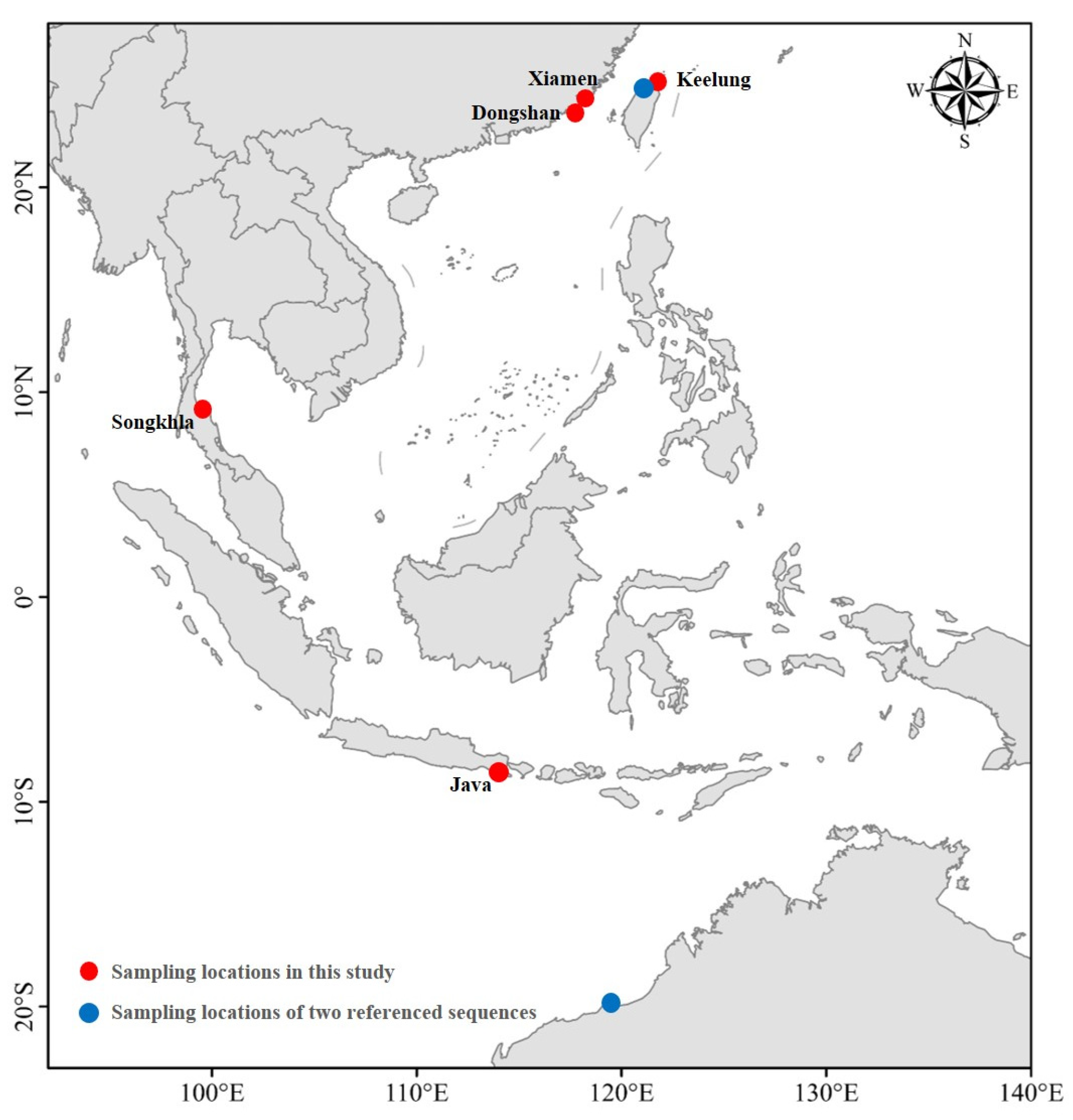
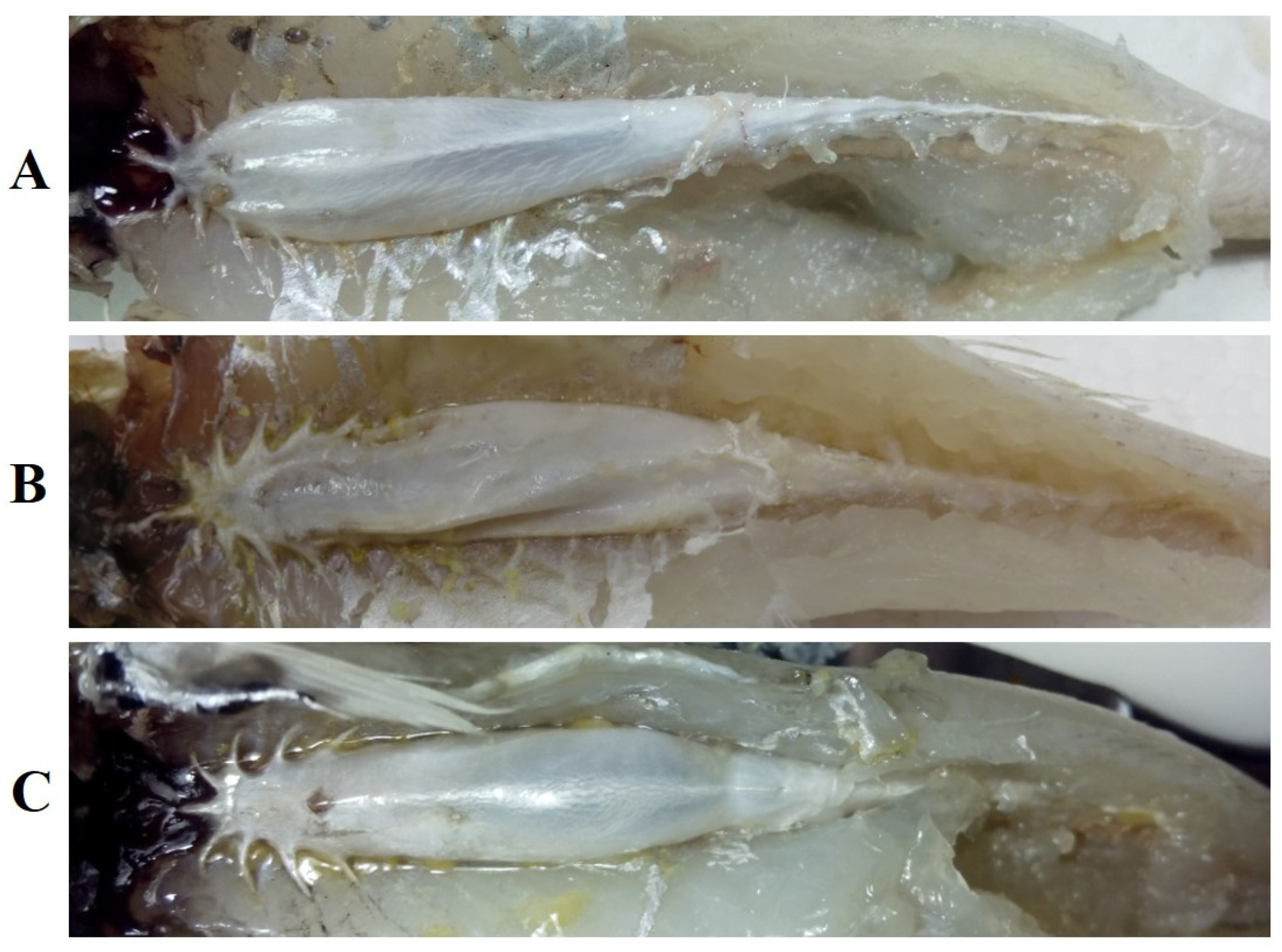
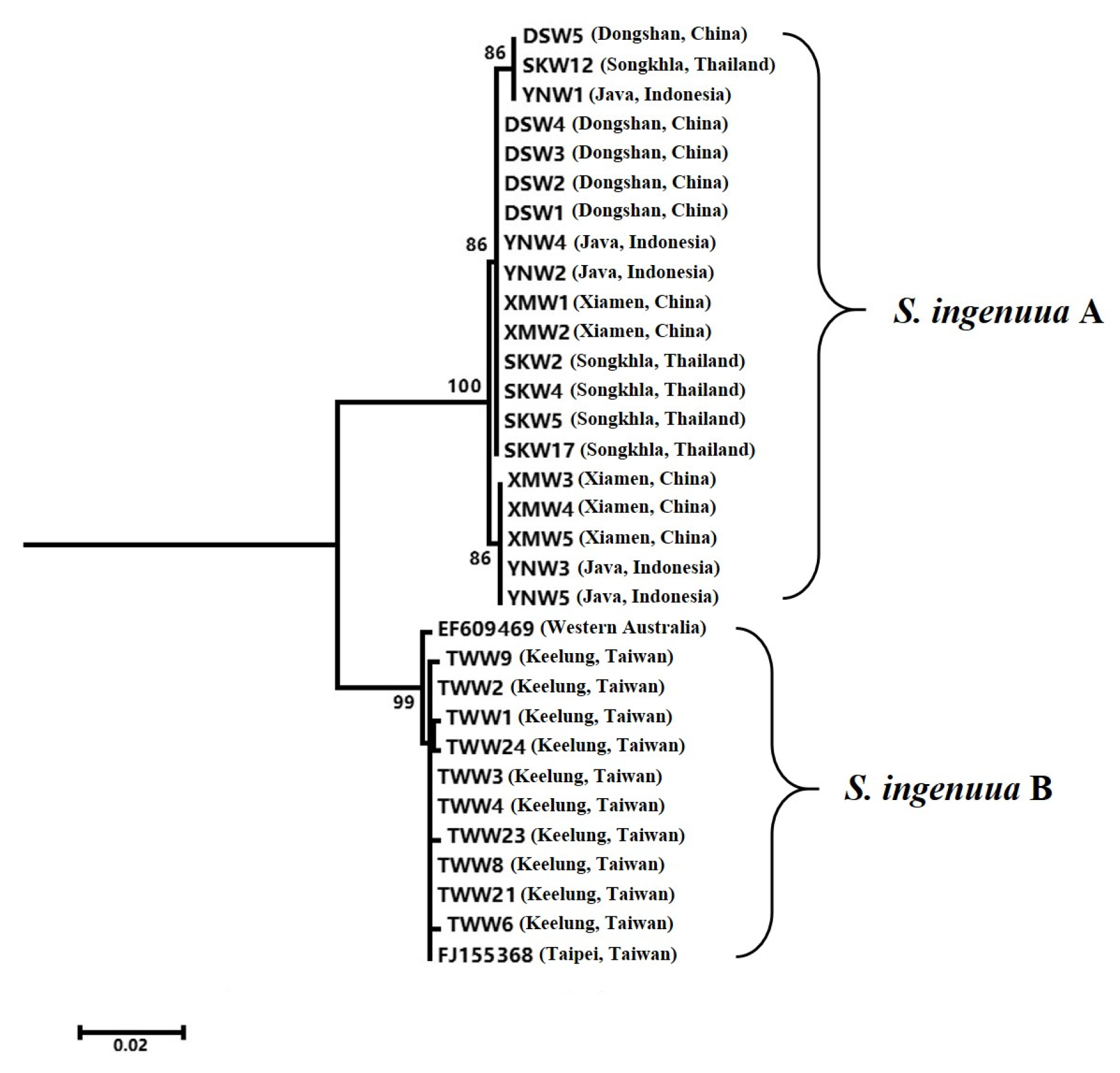
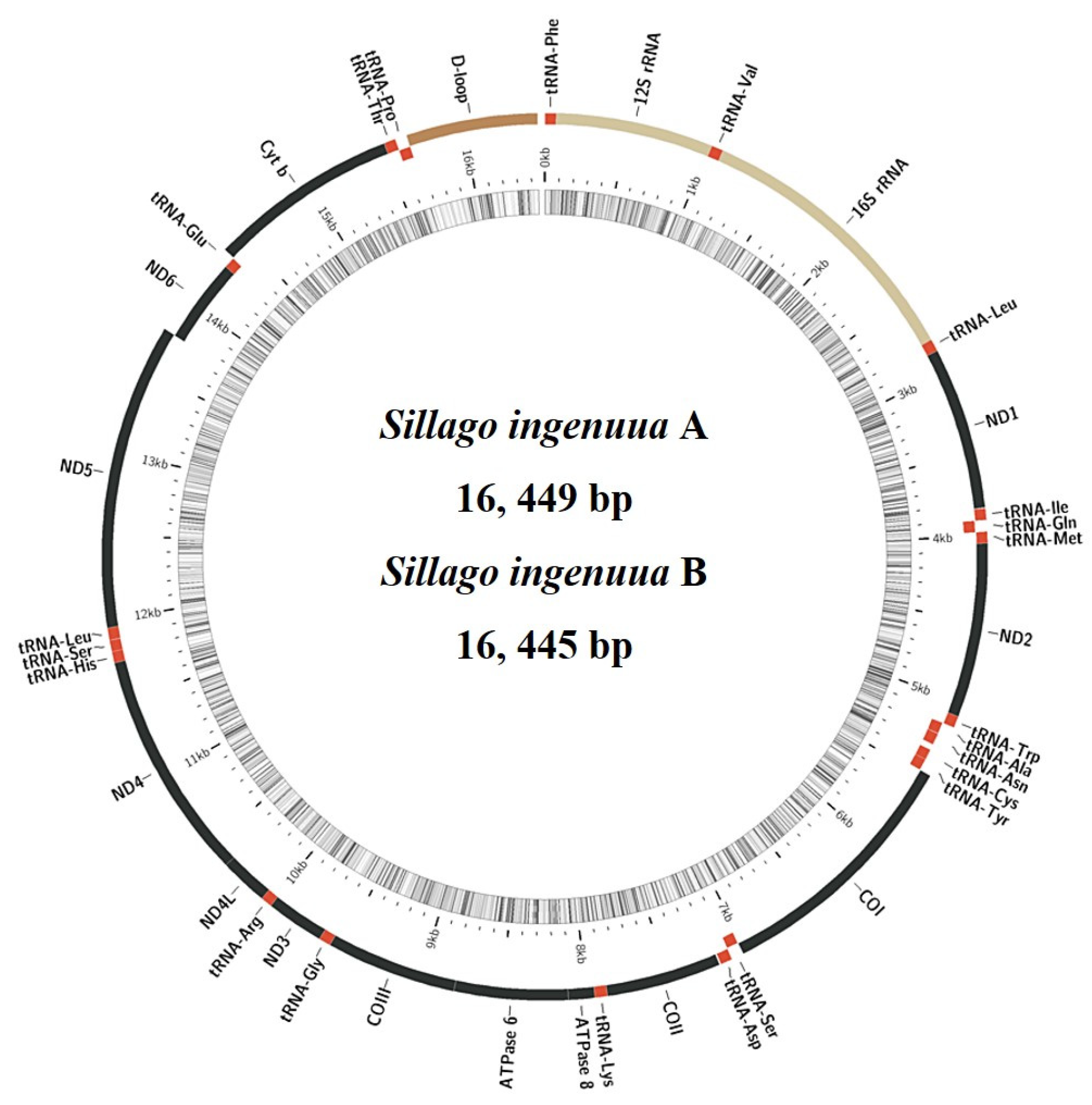
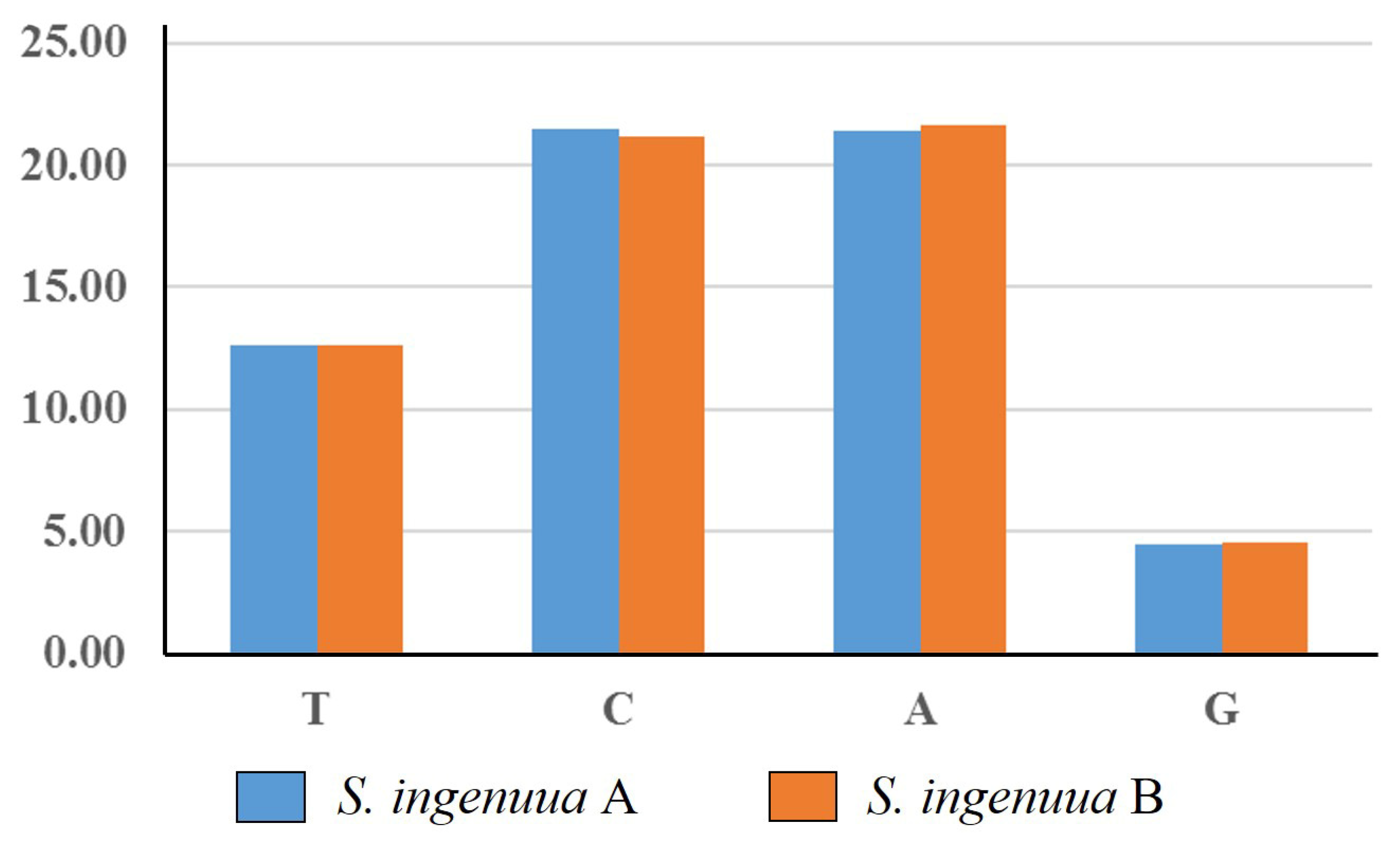
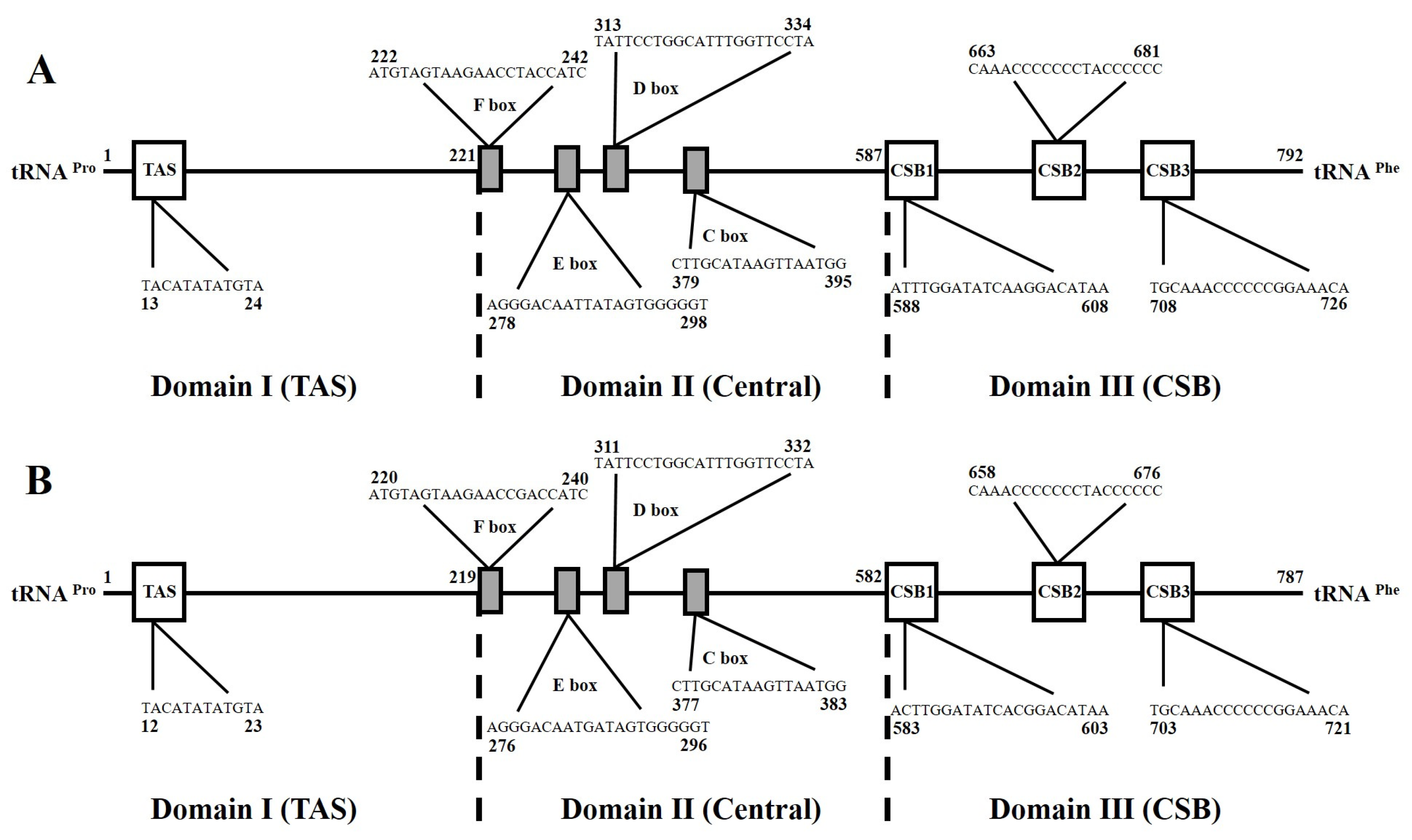
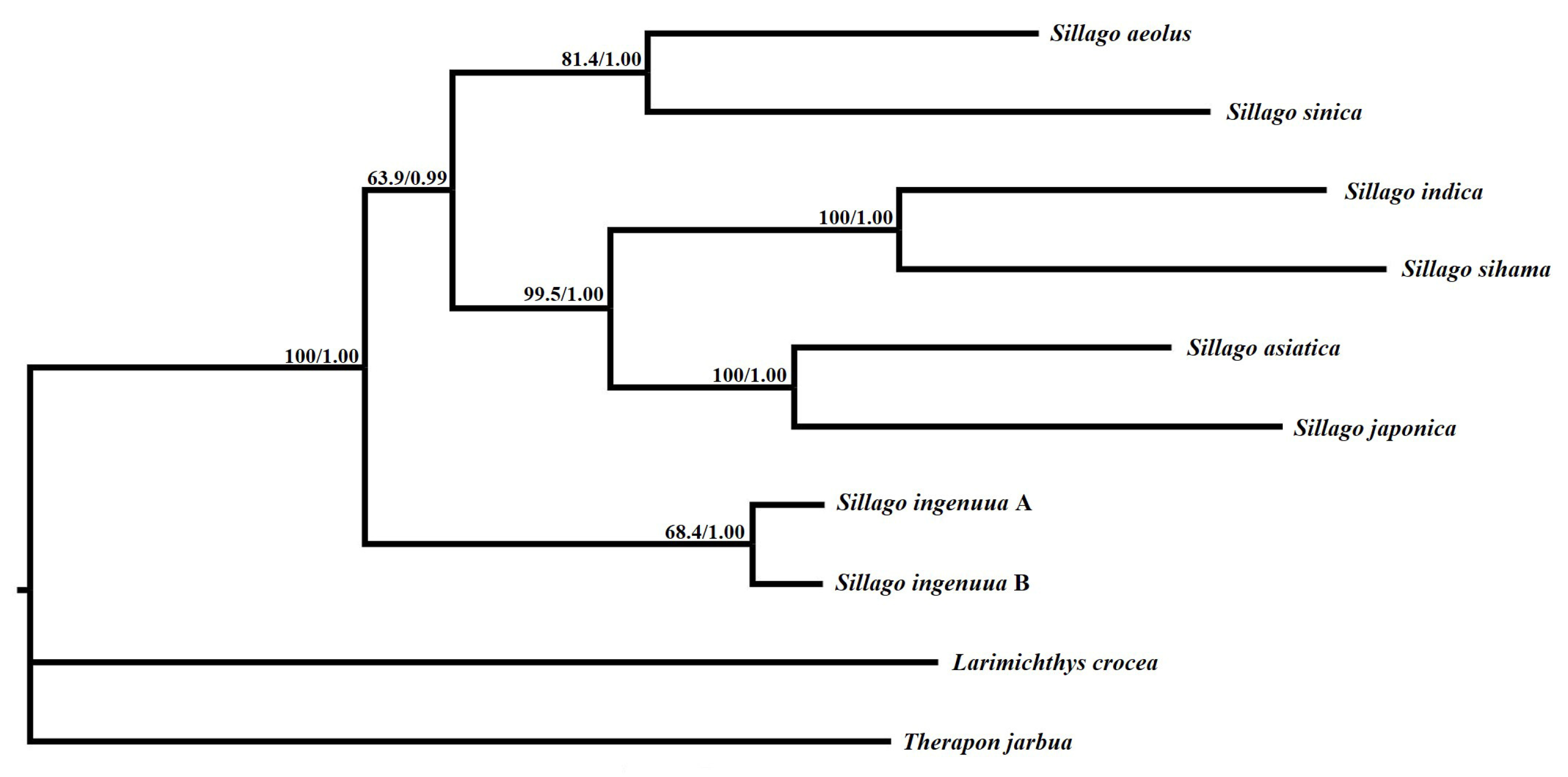
| Dongshan | Xiamen | Keelung | Java | Chantaburi 1 | |
|---|---|---|---|---|---|
| TW (g) | 15.7~35.4 | 20.6~35.9 | 24.31~37.27 | 37.7~60.2 | - |
| SL (mm) | 112.5~142.2 | 124.0~138.8 | 111.2~140.0 | 144.0~178.4 | 105.0~158.0 |
| D | XI, I, 17 | XI, I, 17 | XI~XII, I, 16~17 | XI, I, 16~17 | XI, I, 17 |
| A | II, 17 | II, 17 | II, 17 | II, 16~18 | II, 17 |
| V | I, 5 | I, 5 | I, 5 | I, 5 | - |
| P | 14~16 | 15~16 | 15~16 | 16 | - |
| C | 17~18 | 17~18 | 17~18 | 17~18 | - |
| Scales on lateral line | 64~68 | 65~69 | 66~68 | 65~69 | 66~70 |
| Scales above lateral line | 3~4 | 3~4 | 3~4 | 3~4 | 3~4 |
| Scales below lateral line | 8~9 | 8~9 | 8~9 | 7~9 | 8~9 |
| Gill rakers | 3~4/8~10 | 3~4/8~10 | 3~4/8~10 | 3~4/8~10 | - |
| Vertebrae 2 | 13 + 7~11 + 9~13 = 33 | 13 + 8~10 + 10~12 = 33 | 13 + 9 + 11 = 33 | 13 + 8~10 + 10~12 = 33 | 13 + 9~11~9~11 = 33 |
| Gene/Region | Position | Size (bp) Nucleotide (A/B) | Amino Acid | Gap 2 (A/B) | Codon | Strand | ||
|---|---|---|---|---|---|---|---|---|
| From (A/B) | To (A/B) | Start | Stop 1 | |||||
| tRNAPhe | 1 | 68 | 68 | 0 | H | |||
| 12S rRNA | 69 | 1015/1016 | 947/948 | 0 | H | |||
| tRNAVal | 1016/1017 | 1087/1088 | 72 | 0 | H | |||
| 16S rRNA | 1088/1089 | 2781 | 1694/1693 | 0 | H | |||
| tRNALeu(UUR) | 2782 | 2855 | 74 | 0 | H | |||
| ND1 | 2856 | 3830 | 975 | 324 | 4 | ATG | TAA | H |
| tRNAIle | 3835 | 3904 | 70 | −1 | H | |||
| tRNAGln | 3904 | 3974 | 71 | −1 | L | |||
| tRNAMet | 3974 | 4043 | 70 | −1 | H | |||
| ND2 | 4043 | 5088 | 1046 | 348 | 0 | ATG | TA | H |
| tRNATrp | 5089 | 5159 | 71 | 0 | H | |||
| tRNAAla | 5160 | 5229 | 70 | 1 | L | |||
| tRNAAsn | 5231 | 5303 | 73 | 0 | L | |||
| OL | 5304 | 5342 | 39 | −3 | H | |||
| tRNACys | 5340 | 5405 | 66 | 0 | L | |||
| tRNATyr | 5406 | 5475 | 70 | 1 | L | |||
| CO I | 5477 | 7027 | 1551 | 516 | 0 | GTG | TAA | H |
| tRNASer(UCN) | 7028 | 7098 | 71 | 2 | L | |||
| tRNAAsp | 7101 | 7172 | 72 | 10 | H | |||
| CO II | 7182/7183 | 7872/7873 | 691 | 230 | 0 | ATG | T | H |
| tRNALys | 7873/7874 | 7946/7947 | 74 | 1 | H | |||
| ATPase8 | 7948/7949 | 8115/8116 | 168 | 55 | −10 | ATG | TAA | H |
| ATPase6 | 8106/8107 | 8789/8790 | 684 | 227 | −1 | ATG | TAA | H |
| CO III | 8789/8790 | 9573/9574 | 785 | 261 | 0 | ATG | TA | H |
| tRNAGly | 9574/9575 | 9645/9646 | 72 | 0 | H | |||
| ND3 | 9646/9647 | 9994/9995 | 349 | 116 | 0 | ATG | T | H |
| tRNAArg | 9995/9996 | 10,064/10,065 | 70 | −1 | H | |||
| ND4L | 10,064/10,065 | 10,360/10,361 | 297 | 98 | −7 | ATG | TAA | H |
| ND4 | 10,354/10,355 | 11,734/11,735 | 1381 | 460 | 0 | ATG | T | H |
| tRNAHis | 11,735/11,736 | 11,803/11,804 | 69 | 0 | H | |||
| tRNASer(AGY) | 11,804/11,805 | 11,871/11,872 | 68 | 2 | H | |||
| tRNALeu(CUN) | 11,874/11,875 | 11,946/11,947 | 73 | 0 | H | |||
| ND5 | 11,947/11,948 | 13,785/13,786 | 1839 | 612 | −4 | ATG | TAA | H |
| ND6 | 13,782/13,783 | 14,303/14,304 | 522 | 173 | 0 | ATG | TAG | L |
| tRNAGlu | 14,304/14,305 | 14,371/14,372 | 68 | 4 | L | |||
| Cyt b | 14,376/14,377 | 15,516/15,517 | 1141 | 380 | 0 | ATG | T | H |
| tRNAThr | 15,517/15,518 | 15,587/15,588 | 71 | −1 | H | |||
| tRNAPro | 15,587/15,588 | 15,657/15,658 | 71 | 0 | L | |||
| Control region | 15,658/15,659 | 16,449/16,445 | 792/787 | H | ||||
| Species | GenBank Accession | Genome | 13 Protein-Coding Genes | 2 rRNA | 22 tRNA | CR | ||||||||
|---|---|---|---|---|---|---|---|---|---|---|---|---|---|---|
| Length (bp) | A + T (%) | Length (bp) 1 | A + T (%) | Length (bp) | A + T (%) | Length (bp) | A + T (%) | Length (bp) | A + T (%) | |||||
| All Positions | 1st Codon Position | 2nd Codon Position | 3rd Codon Position | |||||||||||
| S. ingenuua A | MF958502 | 16,449 | 54.5 | 11,400 | 54.1 | 46.0 | 58.8 | 57.4 | 2641 | 53.7 | 1554 | 53.6 | 792 | 65.4 |
| S. ingenuua B | MF958503 | 16,445 | 54.4 | 11,400 | 54.0 | 46.1 | 58.8 | 57.2 | 2641 | 53.3 | 1554 | 53.7 | 787 | 64.0 |
| S. aeolus | NC025935 | 16,499 | 51.5 | 11,400 | 50.7 | 45.3 | 58.4 | 48.4 | 2638 | 51.5 | 1554 | 53.3 | 846 | 59.2 |
| S. asiatica | NC025337 | 16,493 | 52.0 | 11,400 | 51.1 | 45.6 | 58.8 | 49.0 | 2644 | 51.9 | 1557 | 53.8 | 827 | 59.7 |
| S. indica | NC025298 | 16,647 | 52.8 | 11,400 | 52.2 | 46.2 | 58.4 | 51.9 | 2654 | 52.2 | 1558 | 53.5 | 952 | 61.1 |
| S. japonica | KR363149 | 17,119 | 53.9 | 11,409 | 53.2 | 46.3 | 58.8 | 54.4 | 2677 | 53.2 | 1566 | 54.0 | 1068 | 62.4 |
| S. sihama | KR363150 | 17,003 | 52.3 | 11,400 | 51.5 | 45.3 | 58.5 | 50.8 | 2658 | 51.0 | 1557 | 53.4 | 1026 2 | 60.5 |
| S. sinica | NC030373 | 16,572 | 51.3 | 11,400 | 50.5 | 45.2 | 58.5 | 47.9 | 2648 | 52.1 | 1558 | 53.5 | 831 | 58.2 |
| S. ingenuua A | S. ingenuua B | S. aeolus | S. asiatica | S. indica | S. japonica | S. sihama | |
|---|---|---|---|---|---|---|---|
| S. ingenuua B | 0.069 | ||||||
| S. aeolus | 0.234 | 0.231 | |||||
| S. asiatica | 0.257 | 0.258 | 0.269 | ||||
| S. indica | 0.265 | 0.262 | 0.281 | 0.265 | |||
| S. japonica | 0.267 | 0.264 | 0.279 | 0.232 | 0.271 | ||
| S. sihama | 0.266 | 0.272 | 0.277 | 0.269 | 0.234 | 0.280 | |
| S. sinica | 0.273 | 0.275 | 0.217 | 0.276 | 0.281 | 0.286 | 0.281 |
Disclaimer/Publisher’s Note: The statements, opinions and data contained in all publications are solely those of the individual author(s) and contributor(s) and not of MDPI and/or the editor(s). MDPI and/or the editor(s) disclaim responsibility for any injury to people or property resulting from any ideas, methods, instructions or products referred to in the content. |
© 2023 by the authors. Licensee MDPI, Basel, Switzerland. This article is an open access article distributed under the terms and conditions of the Creative Commons Attribution (CC BY) license (https://creativecommons.org/licenses/by/4.0/).
Share and Cite
Gao, T.; Shi, Y.; Xiao, J. Comparative Mitogenomics Reveals Cryptic Species in Sillago ingenuua McKay, 1985 (Perciformes: Sillaginidae). Genes 2023, 14, 2043. https://doi.org/10.3390/genes14112043
Gao T, Shi Y, Xiao J. Comparative Mitogenomics Reveals Cryptic Species in Sillago ingenuua McKay, 1985 (Perciformes: Sillaginidae). Genes. 2023; 14(11):2043. https://doi.org/10.3390/genes14112043
Chicago/Turabian StyleGao, Tianxiang, Yijia Shi, and Jiaguang Xiao. 2023. "Comparative Mitogenomics Reveals Cryptic Species in Sillago ingenuua McKay, 1985 (Perciformes: Sillaginidae)" Genes 14, no. 11: 2043. https://doi.org/10.3390/genes14112043
APA StyleGao, T., Shi, Y., & Xiao, J. (2023). Comparative Mitogenomics Reveals Cryptic Species in Sillago ingenuua McKay, 1985 (Perciformes: Sillaginidae). Genes, 14(11), 2043. https://doi.org/10.3390/genes14112043







